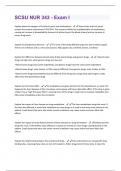Solution Manual For
Fundamentals of Taxation 2024 Edition By Ana Cruz, Michael
Deschamps, Frederick Niswander, Debra Prendergast and Dan Schisler
Chapter 1-15
CHAPTER 1 – SOLUTIONS
END OF CHAPTER MATERIAL
Discussion Questions
1. (Introduction) Give a brief history of the income tax in the United States.
Answer:
The first federal income tax was enacted in 1861 to help finance the Civil War
and was discarded soon thereafter. In 1894, another income tax was
promulgated by Congress to raise additional tax revenue and to expand the
sources of revenue. In 1895, the Supreme Court ruled that the federal income
tax was unconstitutional. In 1913, the sixteenth Amendment to the U.S.
Constitution was enacted. This amendment gave Congress the power to levy
and collect taxes. In 2021, the federal government collected about $1.75 trillion
in individual income taxes.
Feedback:
Learning Objective: 01-01
Topic: Tax Rate Structures
Difficulty: 1 Easy
EA: No
2. (Introduction) For tax year 2021, what proportion of individual income tax returns was
electronically filed?
Answer:
In 2021, electronically filed tax returns were about 90% of total returns.
Feedback: Calculated from Table 1-1
Learning Objective: 01-01
Topic: Tax Rate Structures
Difficulty: 2 Medium
EA: No
3. Name the three types of tax rate structures and give an example of each.
,Answer:
Progressive — U.S. federal income tax
Proportional — ―flat-tax‖ usually levied on property or sales at the state or
local level
Regressive — Social security tax
Feedback:
Learning Objective: 01-01
Topic: Tax Rate Structures
Difficulty: 1 Easy
EA: No
4. What is a progressive tax? Why do you think the government believes it is a more
equitable tax than, say, a regressive tax or proportional tax?
Answer:
A progressive rate structure is a structure where the tax rate increases as the
tax base increases. The progressive rate structure is viewed as more equitable
because the amount of tax paid varies with the ability to pay. For example, the
government believes that as an individual makes more income, a smaller
percentage of that income is needed to buy necessary living supplies and thus
more income is available to pay taxes.
Feedback:
Learning Objective: 01-01
Topic: Tax Rate Structures
Difficulty: 2 Medium
EA: No
5. What type of tax is a sales tax? Explain your answer.
Answer:
The sales tax is a proportional tax. A proportional tax is a tax where the tax
rate remains the same regardless of the tax base. Most county or state sales tax
rates are the same regardless of the amount of sales upon which the tax is
levied. With a proportional tax, the marginal tax rate and average tax rate are
always the same.
Feedback:
Learning Objective: 01-01
Topic: Tax Rate Structures
Difficulty: 1 Easy
EA: No
6. What is the definition of tax base, and how does it affect the amount of tax levied?
,Answer:
The tax base is the dollar amount upon which the tax rate is applied in order
to determine the actual tax. Income, dollar sales, and property value are the
more common tax bases in the United States.
Feedback:
Learning Objective: 01-01
Topic: Tax Rate Structures
Difficulty: 1 Easy
EA: No
7. What type of tax rate structure is the U.S. federal income tax? Explain your answer.
Answer:
The federal income tax is a progressive tax. As the tax base increases, the rate
of tax increases. Tax rates range from a low of 10% to a high of 37%.
Feedback:
Learning Objective: 01-01
Topic: Tax Rate Structures
Difficulty: 1 Easy
EA: No
8. A change to a 17% flat tax could cause a considerable increase in many taxpayers’
taxes and a considerable decrease in the case of others. Explain this statement in light of
the statistics in Table 1-3.
Answer:
Those with taxable income above $200,000 have average tax rates greater than
17%, those with taxable income below $200,000 have average tax rates less
than 17%. Thus, on average, if a 17% flat tax were enacted, those with taxable
income under $200,000 would see their tax liability go up and those with
taxable income over $200,000 would have lower tax liability.
Feedback: Based on the average tax rates in Table 1-3
Learning Objective: 01-01
Topic: Tax Rate Structures
Difficulty: 2 Medium
EA: No
9. Explain what is meant by regressive tax. Why is the social security tax considered a
regressive tax?
Answer:
A regressive tax rate is one where the tax rate decreases as the tax base gets
larger. The social security tax is assessed on the first $160,200 of wages (in
, 2023). Thus, the social security tax rate is 6.2% (12.4% if self-employed) on
the first $160,200 of wages and 0% on wages above $160,200.
Feedback:
Learning Objective: 01-01
Topic: Tax Rate Structures
Difficulty: 1 Easy
EA: No
10. Define and compare these terms: average tax rate and marginal tax rate.
Answer:
The average tax rate is the total tax liability divided by the taxable income (or
tax base). The marginal tax rate is the tax rate applied to the last dollar (or,
more accurately, the next dollar) of taxable income. In a progressive rate
structure, the average tax rate is always the same as or is lower than the
marginal tax rate.
Feedback:
Learning Objective: 01-02
Topic: Average tax rate
Topic: Marginal Tax Rates and Average Tax Rates
Difficulty: 1 Easy
EA: No
11. What is meant by compensation for services? Give some examples.
Answer:
Compensation for services is the broad category used by the IRS to encompass
all forms of economic benefit a taxpayer may receive because of an
employee/employer arrangement. Examples are: wages, salaries, tips, sick pay,
bonuses, fringe benefits, commissions, etc.
Feedback:
Learning Objective: 01-03
Topic: The Components of a Basic Form 1040
Difficulty: 1 Easy
EA: Yes
12. What is the definition of interest?
Answer:
Interest is compensation for the ―use of money‖ with respect to a bona fide
debt or obligation imposed by law (e.g., judgments, loans, installment sales).
Feedback:
Learning Objective: 01-03





